|
The
Last Salute: Civil and Military Funeral, 1921-1969
CHAPTER X
Former Air Force Chief of Staff
General Hoyt S. Vandenberg
Special Military Funeral
2-5 April 1954
General Hoyt S. Vandenberg, Chief of Staff of the Air Force from 1948
to 1953, died at Walter Reed General Hospital on 2 April 1954 at the
age of fiftyfive. He had been ill of cancer for several years and
hospitalized since 7 October 1953.
When it became known that death was imminent, Headquarters, Department
of the Air Force, began to draw up plans for a Special Military Funeral
for the general. Under current Department of Defense policies, General
Vandenberg's status as a retired former Chief of Staff entitled him
to a "combined services full honor ceremony." Authority for
according the greater ceremony of a Special Military Funeral rested
with the Secretary of Defense; in this case it would come from Secretary
Charles E. Wilson.
Several months before the general's death, the Air Force Chief of Chaplains,
Maj. Gen. Charles I. Carpenter, discussed funeral arrangements for the
general with his wife, Gladys Rose Vandenberg. At that time, she preferred
a family service in St. Joseph's Chapel at the Washington National Cathedral
and at Arlington National Cemetery.
Wishing to hold a more elaborate ceremony for the distinguished Air
Force official, Air Force Chief of Staff General Nathan D. Twining,
in January 1954, directed Brig. Gen. Monro MacCloskey, who had been
a member of the same U.S. Military Academy company as General Vandenberg
and who was a long-time friend of the Vandenberg family, to take up
the matter again with Mrs. Vandenberg. General MacCloskey and Mrs. Vandenberg
reached agreement on a larger ceremony. General Vandenberg's body was
to lie in St. Joseph's Chapel at the Washington National Cathedral until
the funeral service, which was to be held in the cathedral nave and
was to be conducted according to rites of the Episcopal Church, of which
the Vandenbergs were communicants. The body was then to be moved in
procession to the entrance of Arlington National Cemetery. From there
a military escort was to accompany the cortege to the gravesite in Section
30, near the graves of William Howard Taft and James V. Forrestal.
[68]
On 2 April General Twining formally assigned primary responsibility
for arranging the funeral to Headquarters Command, US Air Force, at
Bolling Air Force Base, Washington, D.C. Brig. Gen. Stoyte O. Ross,
who headed the command, immediately established a liaison office in
the Pentagon which was manned around the clock through 5 April, the
day of the funeral. General Ross's headquarters meanwhile issued a 44-page
"Special Military Funeral Plan" with ten annexes, a document
based on the plan worked out by General MacCloskey and Mrs. Vandenberg.
The Air Adjutant General, Col. Kenneth E. Thiebaud, was in charge of
sending out announcements of the funeral (in effect, invitations to
attend) to family, friends, and dignitaries. Colonel Thiebaud also handled
seating plans for the cathedral and other matters of protocol, including
details covering the attendance of the family, honorary pallbearers,
and special honor guard. Lt. Gen. Emmett O'Donnell, Jr., the Air Force
Deputy Chief of Staff for Personnel, was responsible for conducting
necessary "negotiations with the Secretary of Defense, appropriate
overseas commanders, and next of kin."
At 0815 on 3 April General Vandenberg's body, which had been taken from
the hospital to the Rinaldi Funeral Home, was moved in procession to
the Washington National Cathedral. Eight body bearers, two each from
the Air Force, Army, and Navy and one each from the Marine Corps and
Coast Guard, led by an Air Force officer, handled the casket. Heading
the procession to the cathedral was a police escort, and following,
with intervals of twenty-five yards between, were the escort commander,
the clergy, the hearse, the body bearers, and a second police escort.
Awaiting the procession at the Bethlehem Chapel entrance to the cathedral
were a cordon of sixteen airmen and an officer, the general's personal
flag bearer, and an Air Force ceremonial band. The band sounded four
ruffles and flourishes and played the "General's March" and
the honor cordon presented arms as the body bearers took the casket
from the hearse. Following the clergy, the body bearers carried the
casket through the Bethlehem Chapel entrance to St. Joseph's Chapel.
In column behind the casket were two representatives of the mortuary,
the flag bearer, and (according to the recollection of the cathedral
verger) the family and honorary pallbearers. The casket was placed on
a bier and an honor guard took post immediately.
The honor guard consisted of one officer and five noncommissioned officers;
sixteen men from the enlisted ranks, four from each of the four armed
forces; and one officer, two petty officers, and two other enlisted
men from the Coast Guard. These troops were provided by the 1100th Air
Base Group, the 3d Infantry, and the Potomac River Naval Command (which
arranged all Navy, Marine, and Coast Guard participation in the ceremonies).
Mess, housing, transportation, and other administrative support for
the honor guard at the chapel were responsibil-
[69]
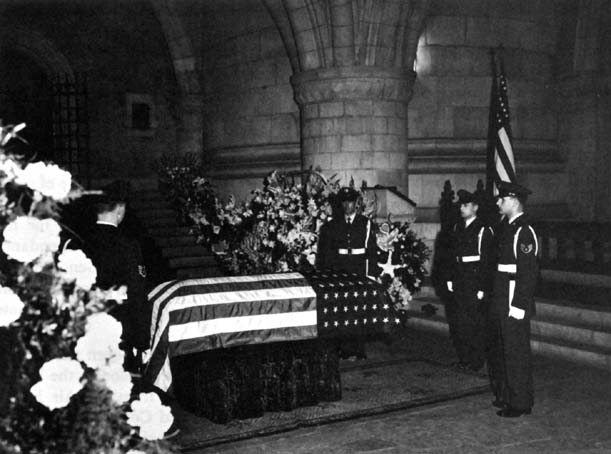
HONOR GUARD STANDS AT THE BIER IN ST. JOSEPH'S CHAPEL
ities of the commander of the 1100th Air Base Group, stationed at Boiling
Air Force Base.
The honor guard stood watch from the morning of 3 April until noon on
5 April, performing its vigil in half-hour reliefs. Each daytime relief
comprised one officer and four noncommissioned officers. A night relief
consisted of one noncommissioned officer and four enlisted men. The
reliefs were posted by service, not in combined formations. (It appears
that the Coast Guard sentinels served in the naval watch rotation.)
As is customary in the Protestant Episcopal Church, the casket remained
closed during this period and during the funeral service as well.
The commander of the 1401st Air Base Wing, a Military Transport Service
unit stationed at Bolling Air Force Base, provided a floral detail whose
members received each flower offering at the cathedral and recorded
the name of the sender. The detail worked around the clock in three
shifts, an officer, three noncommissioned officers, and seven enlisted
men in each shift. Although the actual arranging of flowers was done
by personal friends of the Vandenberg family, in particular, by Mrs.
William Pope Anderson of Washington, DC, the detail from
[70]
the Military Transport Service assisted the family friends later in
the nave of the cathedral and at the gravesite.
The Air Adjutant General's office had meanwhile issued announcements
of the funeral service to Washington officials as required by protocol
and to individuals selected by Mrs. Vandenberg in consultation with
General MacCloskey. These included retired Air Force general officers;
West Point classmates of General Vandenberg; representatives of the
Air Force Officers' Wives Club, Air Force Association, Air Force Arlington
Committee, Civil Air Patrol, Air Force Aid Society, Air Force Historical
Foundation, and other associations; and members of the aircraft and
airline industries. Former President Harry S. Truman was invited but
was not able to attend.
Among those invited to the funeral were twenty-four men who were asked
to serve as honorary pallbearers. Some of these were the general's personal
friends, others were associates from the military services, the Central
Intelligence Agency, the diplomatic corps, and the aircraft industry.
Seventeen were able to participate and officer guides were detailed
to assist them during the ceremonies.
The funeral service announcements, along with tickets for seats in the
cathedral, were delivered by courier to residents of the Washington
area. Others were notified by telegraph and given seating information.
Fifty ushers, all officers from Bolling Air Force Base and Andrews Air
Force Base, were appointed and given detailed instructions on directing
the seating in the various sections of the cathedral nave. (Diagram
11)
A minor ceremonial arrangement peculiar to the services for General
Vandenberg concerned the special honor guard. This formation traditionally
consists of the chairman of the joint Chiefs of Staff, the chiefs and
vice chiefs of staffs of the three military departments, and the commandants
and assistant commandants of the Marine Corps and Coast Guard. Out of
a decision to make this group an even number, General J. Lawton Collins,
formerly Army Chief of Staff and now US Military Representative to the
North Atlantic Treaty Organization, was added. Later, when it turned
out that the assistant commandant of the Coast Guard could not attend,
the chief of the office of operations of that service was substituted.
At noon on 5 April the body bearers moved General Vandenberg's casket
from St. Joseph's Chapel to a bier in the nave. The floral pieces were
brought into the nave and arranged around the pulpit and lecturn, and
the honor guard again was posted. This time, in contrast to the posting
of reliefs by service during the vigil in St. Joseph's Chapel, a joint
service relief took post in the nave, a system followed until the beginning
of the funeral service at 1400.
Dignitaries attending the funeral included President Dwight D. Eisenhower,
the Secretary of Defense, the three service secretaries, the Secretary
of State, and the Secretary of the Treasury. The service was conducted
by the Very Reverend Francis B. Sayre, dean of the Washington National
Cathedral, who was assisted
[71]

Diagram 11. Washington National Cathedral seating plan.
[72]
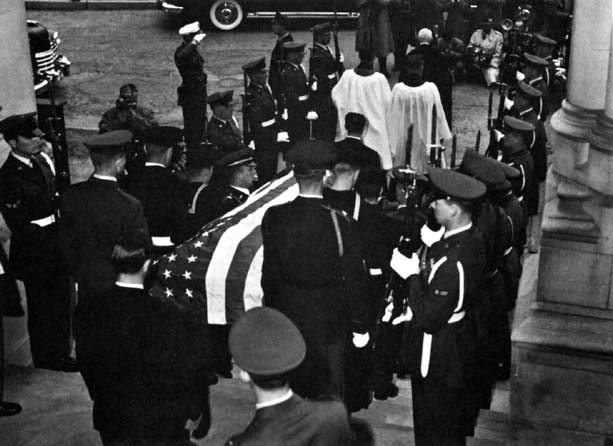
CASKET IS CARRIED OUT OF THE CATHEDRAL
by the Reverend Frank E. Pulley, Chaplain of the US Military Academy.
In the course of a simple ceremony read from the Book of Common Prayer,
the West Point Cadet Choir sang the academy hymn, "The Corps."
No eulogy was delivered.
At the conclusion of the service, President Eisenhower left the cathedral
and returned to the White House. After his departure the cathedral verger
and the clergy led the way from the nave of the cathedral, followed
by the honorary pall bearers who formed a cordon along the north transept
aisle. Two body bearers then wheeled the casket on its movable bier
through the cordon of pallbearers to the north entrance, where the remaining
body bearers waited. Here the full contingent of body bearers took the
casket and, followed by the personal flag bearer, family group, special
honor guard, and other mourners, carried it through a cordon of sixteen
airmen stationed on the entrance steps. The Air Force ceremonial band,
across the street from the cortege vehicles, played while the casket
was carried out and placed in the hearse. Those who were to travel in
the cortege entered their automobiles and the motorcade departed. (Diagram
12) The body
[73]
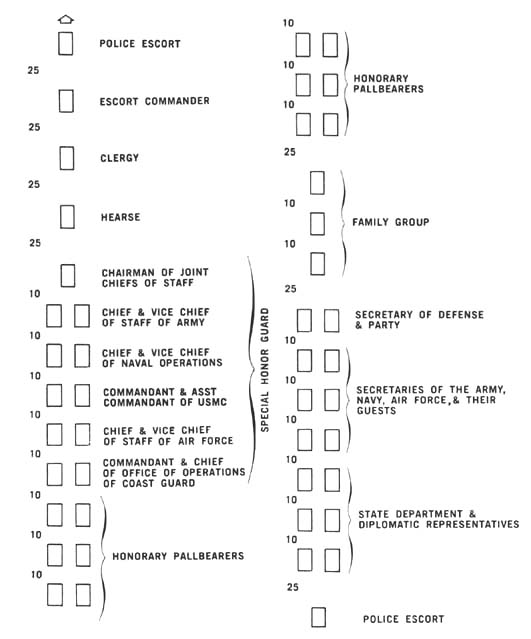
Diagram 12. Order of march, Washington National Cathedral to Arlington
National Cemetery.
[74]
bearers and flag bearer proceeded by a separate route in order to reach
Memorial Gate of the cemetery ahead of the procession.
The cortege moved to Arlington National Cemetery via Woodley Road, Cathedral
Avenue, Rock Creek Parkway, Memorial Bridge, and Memorial Drive. Waiting
in column on Memorial Drive was the military escort, whose units included
the US Air Force Band, the US Army Band, a battalion of cadets from
the US Military Academy, a battalion of midshipmen from the US Naval
Academy, a battalion of air cadets from Lackland Air Force Base, and
a combined services battalion. This last battalion, commanded by a lieutenant
colonel from the 3d Infantry with a staff of three company grade officers
from the Marine Corps, Navy, and Air Force, contained a reduced company
(one officer and forty-one men) each from the Army, Marine Corps, Navy,
and Air Force. It was massed on an eight-man front, whereas the other
battalions were massed on a nine-man front. Only the cadets and midshipmen
carried arms. Also waiting were the body bearers, personal flag bearer,
and a combined services national color detail.
When the cortege arrived it proceeded to the rear escort unit, where
it halted while the color detail took position at the head of the procession,
with the body bearers on either side of the hearse and the personal
flag bearer immediately be hind the hearse. The escort commander (an
Air Force major general) and his staff of field grade Army, Marine Corps,
and Navy officers then moved to the head of the military escort and
led the full procession into the cemetery. (Diagram 13)
The column proceeded on Roosevelt Drive, Weeks Drive, and Sheridan Drive
toward the gravesite in Section 30. Along the route was a cordon of
airmen from Bolling and Andrews Air Force Bases posted at intervals
of about fifteen feet. When the hearse entered Memorial Gate, the 3d
Infantry battery, in position along Weitzel Drive at the north end of
the cemetery, began a 17-gun salute, firing the rounds at fifteen-second
intervals. Before the procession reached the gravesite, six B-47 Stratojets
flew over in V-formation with the second position on the right empty
as a salute to a fallen comrade. The bombers were followed by a flight
of sixteen F-84 Thunderjets and sixteen F-86 Sabrejets.
When the procession reached the intersection of Sheridan Drive with
Sherman Drive just above the gravesite, the escort commander and all
escort units except the US Air Force Band and US Military Academy Cadet
Company A-1 (General Vandenberg's company when he was a cadet) turned
west on Sherman away from the gravesite. These units, not scheduled
for further participation in the ceremonies, continued west on Sherman
to the cemetery's administrative area parking lot and boarded buses
to return to their respective duty stations.
Already in position at the graveside were an Army company, Marine Corps
company, Navy company, and an Air Force squadron, each consisting of
three officers and sixty-six men. These units were headed by an Air
Force colonel (with a
[75]
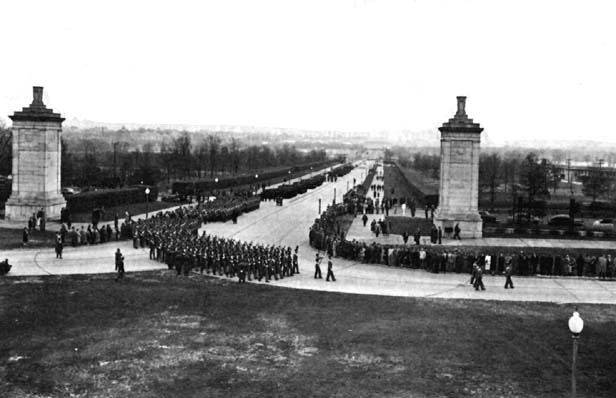
MILITARY UNITS OF THE PROCESSION ENTER THE CEMETERY,
above.
Cortege nears the gravesite, below.

[76]
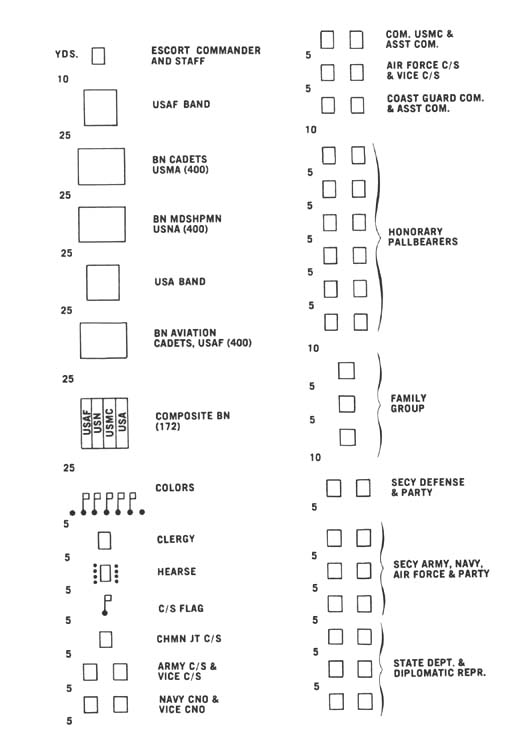
Diagram 13. Order of march, Memorial Gate to gravesite.
[77]
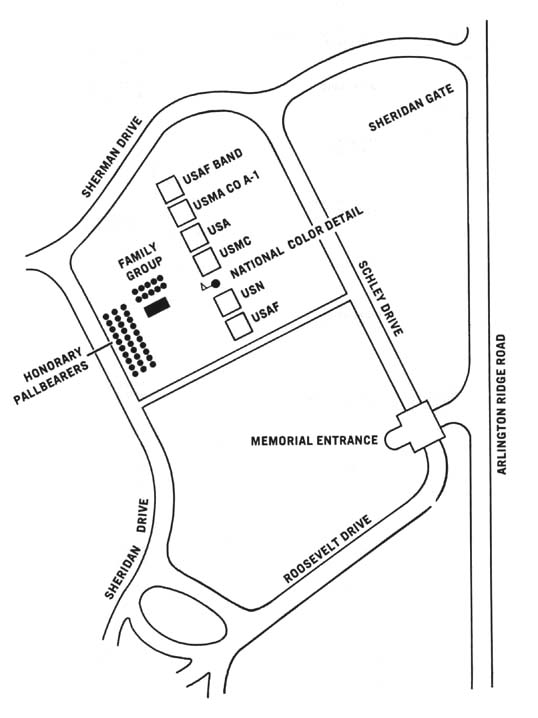
Diagram 14. Formation at the graveside.
[78]
combined services staff of field grade officers) who would serve as
escort commander during the graveside rites. Upon reaching the graveside
the Air Force Band, Cadet Company A-1, and the national color detail
joined the formation, in which each company was massed on a six-man
front at close interval.
After the cortege halted on Sheridan Drive opposite the gravesite, the
honorary pallbearers dismounted and formed a cordon along a pathway
leading to the grave. The special honor guard and the Vandenberg family
moved directly to positions at the grave. (Diagram 14) The body
bearers then removed the casket from the hearse and, preceded by the
clergy and followed by the personal flag bearer, carried General Vandenberg's
casket to the grave. When the casket cleared the honorary pallbearers,
they followed in a column of two to their graveside positions. As the
casket was moved, the escort troops saluted and the band played four
ruffles and flourishes and the "General's March."
Dean Sayre and Chaplain Pulley performed the graveside service. At its
conclusion, the escort units saluted and the 3d Infantry battery fired
seventeen guns. A bugler then sounded taps, which was echoed by a second
bugler. At the last
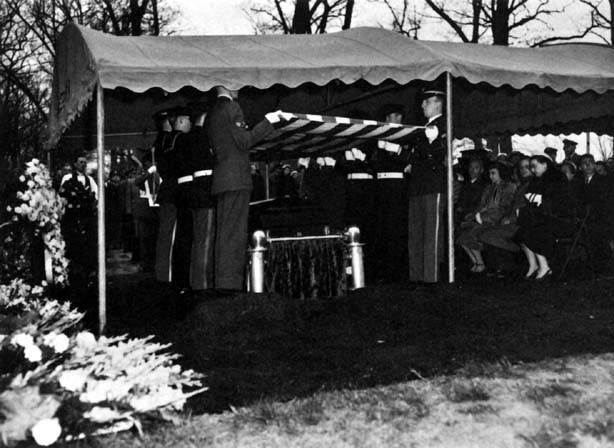
LAST RITES AT THE GRAVESIDE
[79]
note the escort troops ordered arms. The body bearers then folded the
flag that had draped the casket and handed it to Dean Sayre. He in turn
presented it to the general's son, Lt. Hoyt S. Vandenberg, Jr., who
received it for his mother.
The ceremonies for General Vandenberg had been marked by several departures
from the prescribed Special Military Funeral, notably by the absence
of the horse-drawn caisson, the omission of three volleys by a firing
squad at the grave side, and the addition of a flyover of jet aircraft
with one plane missing from the formation.
[80]
Previous Chapter
Next Chapter
|









